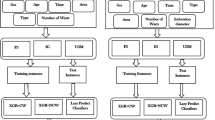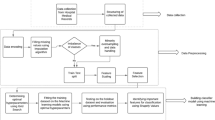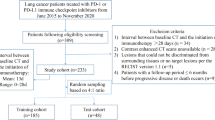Abstract
Warts are benign tumors, caused due to the infection of human papillomavirus (HPV). The identification of wart-specific treatment methods is pertaining to major challenges such as class imbalance, prediction accuracy, and biased nature of learning algorithm. In this article, a bagged ensemble of cost-sensitive extra tree classifier (BECSETC) is developed toward the selection of wart-specific treatment methods. BECSETC outperforms the state-of-the-art techniques (SOTA) by a margin of (0–45, 0\(-\)31.60), (0–12, 0\(-\)2.6) in terms of sensitivity and specificity which overcome the imbalanced distribution on both immunotherapy and cryotherapy datasets. However, on merged dataset, BECSETC algorithm gave an improvement of 6.04\(-\)10.57%, and 4.63% in terms of sensitivity and specificity, as compared to SOTA techniques.




Similar content being viewed by others
Data availability
Both immunotherapy and cryotherapy datasets are available in the UCI machine learning repository.
References
Abdar M, Wijayaningrum VN, Hussain S, Alizadehsani R, Plawiak P, Acharya UR, Makarenkov V (2019) Iapso-airs: a novel improved machine learning-based system for wart disease treatment. J Med Syst 43(7):220
Akben SB (2018) Predicting the success of wart treatment methods using decision tree based fuzzy informative images. Biocybern Biomed Eng 38(4):819–827
Akyol K, Karacı A, Gültepe Y (2018) Study on prediction success of machine learning algorithms for wart treatment. In: International Conference on Advanced Technologies, Computer Engineering and Science. pp 186–188
Bajeh AO, Adeleke HO, Mojeed HA, Balogun AO, Abikoye OC, Usman-Hamza FE (2021) Ensemble models for predicting warts treatment methods. J Eng Sci Technol 16(2):1030–1052
Cai D, He X, Han J (2008) Training linear discriminant analysis in linear time. In: 2008 IEEE 24th International Conference on Data Engineering. IEEE. pp 209–217
Çifci A, Şimşir M (2019) A study on method prediction for a better directed treatment of warts
Cüvitoglu A, Isik Z (2018) Evaluation machine learning approaches for classification of cryotherapy and immunotherapy datasets. Int J Mach Learn Comput 4(4):331–335
Durmuş B, Güneri Öİ (2020) Investigation of factors affecting immunotherapy treatment results by binary logistic regression and classification analysis. Int J Innov Technol Interdiscip Sci 3(3):467–473
Elkarami B, Alkhateeb A, Rueda L (2016) Cost-sensitive classification on class-balanced ensembles for imbalanced non-coding rna data. In: 2016 IEEE EMBS International Student Conference (ISC), pp 1–4. https://doi.org/10.1109/EMBSISC.2016.7508607
Ghiasi MM, Zendehboudi S (2019) Decision tree-based methodology to select a proper approach for wart treatment. Comput Biol Med 108:400–409
Hu J, Ou X, Liang P, Li B (2021) Applying particle swarm optimization-based decision tree classifier for wart treatment selection. Complex Intell Syst 8:163–177
Ito Y, Kennan RP, Watanabe E, Koizumi H (2000) Assessment of heating effects in skin during continuous wave near-infrared spectroscopy. J Biomed Opt 5(4):383–390
Jia W, Xia H, Jia L, Deng Y, Liu X (2020) The selection of wart treatment method based on synthetic minority over-sampling technique and axiomatic fuzzy set theory. Biocybern Biomed Eng 40(1):517–526
Khatri S, Arora D, Kumar A (2018) Enhancing decision tree classification accuracy through genetically programmed attributes for wart treatment method identification. Procedia Comput Sci 132:1685–1694
Khozeimeh F, Alizadehsani R, Roshanzamir M, Khosravi A, Layegh P, Nahavandi S (2017) An expert system for selecting wart treatment method. Comput Biol Med 81:167–175
Lee J-S, Kuo Y-M, Chung P-C, Chen E-L (2007) Naked image detection based on adaptive and extensible skin color model. Pattern Recognit. 40(8):2261–2270
Mishra A, Reddy US (2020) Machine learning approach for wart treatment selection: prominence on performance assessment. Netw Model Anal Health Inform Bioinform 9:1–14
Mishra A, Uyyala SR et al (2021) A novel probabilistic-based deep neural network: toward the selection of wart treatment. Cogn Comput 14(5):1643–1659
Motwani A, Shukla PK, Pawar M (2021) Novel framework based on deep learning and cloud analytics for smart patient monitoring and recommendation (SPMR). J Ambient Intell Humaniz Comput 14:5565–5580
Nabwey HA (2020) A methodology based on rough set theory and hypergraph for the prediction of wart treatment. Int J Eng Res Technol 13(3):552–559
Nugroho HW, Adji TB, Setiawan NA (2018) Random forest weighting based feature selection for c45 algorithm on wart treatment selection method. Int J Adv Sci Eng Inf Technol 8(5):1858
Putra MA, Setiawan NA, Wibirama S (2018) Wart treatment method selection using adaboost with random forests as a weak learner. Commun Sci Technol 3(2):52–56
Rahman M, Zhou Y, Wang S, Rogers J et al (2020) Wart treatment decision support using support vector machine. I J Intell Syst Appl 12(1):1–11
Rahmat GA, Primartha R, Wijaya A et al (2019) Comparative analysis of classification method for wart treatment method. J Phys Conf Ser 1196:012012
Sikkandar MY, Alrasheadi BA, Prakash N, Hemalakshmi G, Mohanarathinam A, Shankar K (2021) Deep learning based an automated skin lesion segmentation and intelligent classification model. J Ambient Intell Humaniz Comput 12(3):3245–3255
Acknowledgement
Abinash Mishra would like to thank the Ministry of Human Resource Development (MHRD) for providing financial support (Grant number 405117002). Also, we would like to thank the Machine Learning and Data Analytics Lab, Department of Computer Applications, National Institute of Technology, Tiruchirappalli; National Forensic Sciences University, Gandhinagar and Ministry of Home Affairs for the infrastructure support.
Author information
Authors and Affiliations
Corresponding author
Ethics declarations
Conflict of interest
Authors declare that they have no conflict of interest.
Ethical approval
This article does not contain any studies with human participants or animals performed by any of the authors.
Additional information
Publisher's Note
Springer Nature remains neutral with regard to jurisdictional claims in published maps and institutional affiliations.
Rights and permissions
Springer Nature or its licensor (e.g. a society or other partner) holds exclusive rights to this article under a publishing agreement with the author(s) or other rightsholder(s); author self-archiving of the accepted manuscript version of this article is solely governed by the terms of such publishing agreement and applicable law.
About this article
Cite this article
Mishra, A., Reddy, U.S. & Reddy, A.V. An improved cost-sensitive approach toward the selection of wart treatment methods. Netw Model Anal Health Inform Bioinforma 12, 39 (2023). https://doi.org/10.1007/s13721-023-00433-2
Received:
Revised:
Accepted:
Published:
DOI: https://doi.org/10.1007/s13721-023-00433-2




